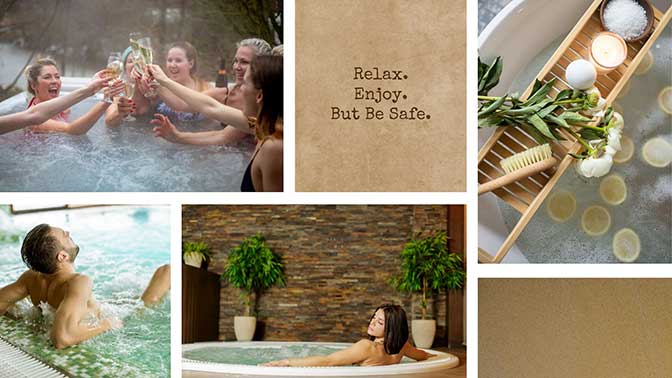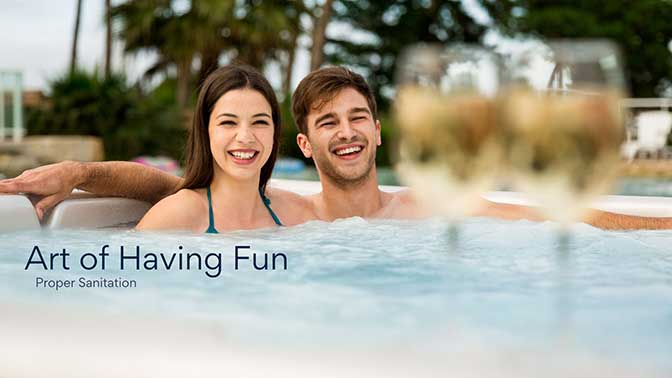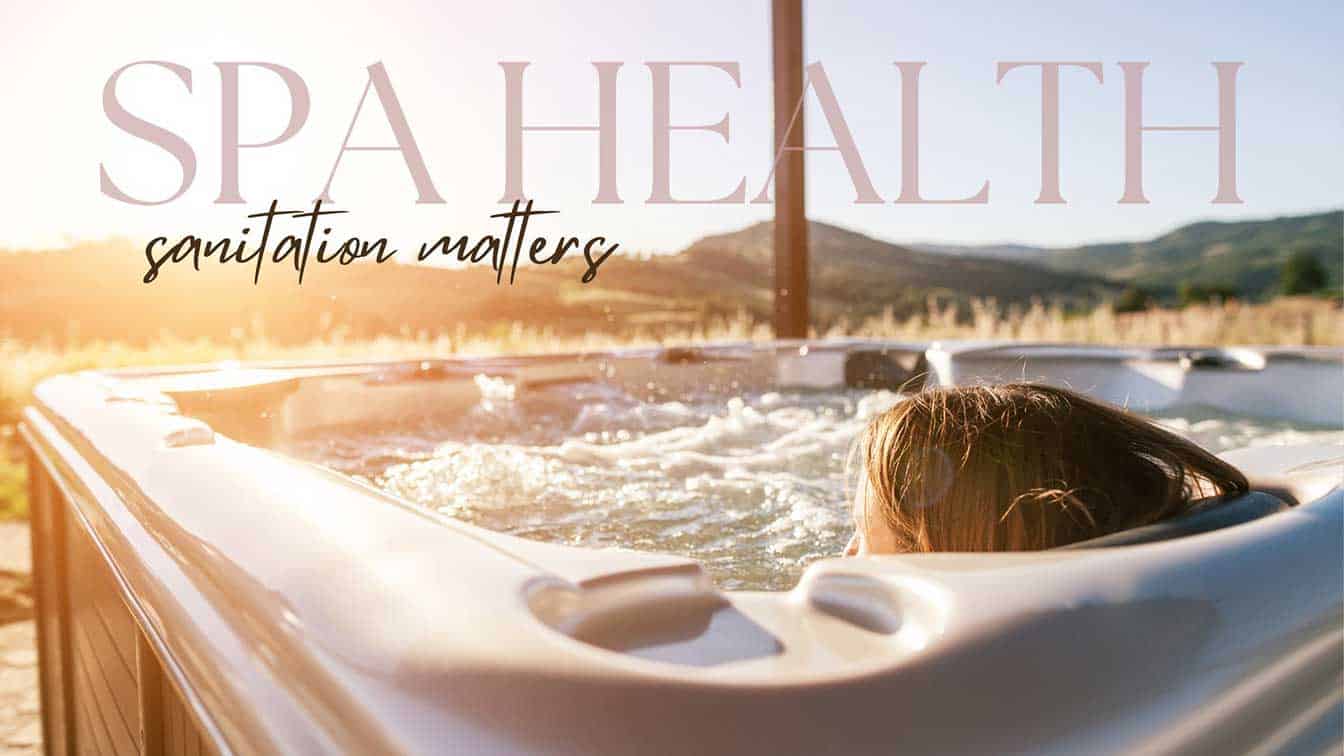Spa Sanitation Matters: Health Concerns for Hydrotherapy Tubs and Jacuzzis
After a long day at work, Jacuzzis can feel like the best, most relaxing gift you can give to yourself. Using a Jacuzzi has loads of health benefits, too, such as the soothing of arthritis to the easing of a migraine. However, bacteria love the inside of a Jacuzzi and that can make problems for the body’s immune system.
By now, everyone knows the dangers that may be lurking in a pedicure tub. When it comes to whirlpool tubs and Jacuzzis, you need to be just as careful. After all, for the most part, you may consider a whirlpool or hydrotherapy tub like one big jetted pedicure foot tub. These hydrotherapy tubs may harbor a safety concern for spa-goers, and individuals who have these tubs in their home.
Due to the overwhelming responses from individuals wanting to know about the safety of the whirlpools, Jacuzzis and hydrotherapy tubs, Spavelous changed topics this week so we could address your many concerns. These concerns certainly are real, and a study by a Texas A&M University microbiologist shows that whirlpool bathtubs can literally be a breeding ground for dozens of types of bacteria, many of them potential pathogens, and such water can be a ground zero for infectious diseases.

Please keep in mind that this is not just a challenge found at spas, it may also be a challenge if you have an at-home Jacuzzi or whirlpool bathtub.
Microbiologist Rita B. Moyes tested 43 water samples from whirlpool bathtubs — both private and public ones — and found that all 43 had bacterial growth ranging from mild to red-level dangerous. A whopping 95 percent showed the presence of fecal derived bacteria, while 81 percent had fungi and 34 percent contained staphylococcus, which can cause deadly staph infections.
The main reason that whirlpool baths are almost a prime breeding ground for potentially harmful bacteria in the lining of the pipes. They are full of inaccessible air, and water in these pipes tends to get trapped, often for long periods of time. The stagnant water in a whirlpool bathtub pipe is a great place for bacteria to grow and grow. When the jets are then switched on, this water with harmful bacteria gets blown into the tub where a person is soaking.
Bacteria can lead to numerous diseases, among them urinary tract infections, septicemia, several types of skin infections, severe skin rashes, eye and ear infections, and pneumonia… Because of the aerosol mist created by the whirlpool action, microbes are forced into the lungs or open cuts. One type of bacteria, L. pneumophila, can cause Legionnaires Disease, of which 90 percent of all cases can be traced back to bacteria developed from a warm environment.
These bacteria can be easily controlled and removed by properly cleaning the hydrotherapy tubs and maintaining the disinfectant levels in Jacuzzis. In this week’s Spavelous “Now You Are In The Know” spa magazine how to ensure your safety, what to look for and what questions to ask prior to scheduling your appointment.
Hydrotherapy Treatments: Important Part of Spa Sanitation …
What you should know before you go? Although there are some risks associated with using a hot tub, these risks are rarely the ones you may think of. The greatest hazard you face when getting into a hot tub is drowning.
The U.S. Consumer Product Safety Commission alerts us to the fact that hot tubs can entangle a person’s hair or body parts. Children and adults alike have been held to the bottom of a hot tub by the suction generated from the drain and drowned. Make sure that their spa has dual drains in the tub, (which helps to distribute any suction), and drain covers which are not cracked or broken.
Note where the emergency cut-off switch is so you can turn it off in an emergency. This is also a good thing to keep in mind before getting inside a steam room or sauna. Do not drink alcohol before or while in a hot tub. The combination of heat and alcohol can cause you to lose consciousness and drown.
Individual Hydrotherapy Tubs
Individual Hydrotherapy Tubs are emptied after each individual use. First, prior to considering this treatment, you will need to verify that a hydrotherapy treatment is right for you and that you do not have any contraindications due to either the heat from the treatment or the products used.
Before booking your hydrotherapy treatment, you should ask the spa what type of individual hydrotherapy tubs they have. Many spas offer the safer antibacterial pipeless technology with removable jets hydrotherapy spas. Next, ask what sanitation procedures they use between clients.
They should use the correct procedures as outlined by your states health code. This means that the tub should be emptied with the tub and jets properly sanitized, wiped out, disinfected with approved sanitizers, rinsed and dried out. If this is a piped jet system, this means that the sanitized solution must be run through the jets for a specified time period.
If you are staying at a Hotel or Resort that has a jetted tub in your guest room, either bring your own cleaners to insure the tub’s safety or ask the resort to send someone up so you may observe the proper sanitation is done. At home, make sure that you adhere to your manufacturer’s direction for proper cleaning and disinfection. This should be done both after and before each use.

Group Jacuzzi or Whirlpools
Group Jacuzzi or Whirlpools are used by multiple people with the water filtered, chemical treated, emptied weekly or monthly in accordance with the manufacturer. If this is a group Jacuzzi, check and make sure that the Jacuzzi has the appropriate drain cover valves, you should have your hair up and secured so that the hair will not clog the filter or get caught in the intake valve.
The integrity of the water in your hot tub or spa is critical to your health and maintenance of the unit. Check to see what chemicals they use to maintain the water quality. Some chemicals used may include bromine tablets, water clarifiers, PH plus, spa shock and demineralized.
These are necessary for water safety. Other chemicals that are not necessarily required but depending on water type and preference you may want to stock are water softener and defoamer. Personally, I do not use public Jacuzzis as the chlorine is not good for your skin.
Alternatives to Chlorine
What Types of Dangers Does Chlorine Pose?
Chlorine is one of the most commonly used chemical agents in the world. In addition to being utilized for spa and swimming pool maintenance, this substance is an ingredient in many household cleaners and is a strong bleaching agent. As with most powerful chemicals, there are risks associated with chlorine usage.
Cancer Concerns
Perhaps the most significant of the dangers of chlorine in spas relates to the association between the chemical and cancer. Some studies indicate that there is an association between the absorption of chlorine through the skin and certain kinds of cancers. Because the water in spas is maintained at such high temperatures, it is believed that there is an increased likelihood of chlorine absorption through the pores in this type of environment.
There are alternatives for those concerned about the dangers of chlorine in spas.
Bromine:
Some people choose bromine as an alternative to chlorine. Even though bromine is still a chemical additive, it does not have the same harsh smell like chlorine and is easier to use. However, this substance is not without risk.
BaquaSpa Water Care System:
This system is free from both chlorine and bromine. The system is an effective protection against harmful bacteria and microorganisms without the harsh chlorine smell or other potentially harmful effects. BaquaSpa has a reputation for being gentle to skin and eyes. The active microbial ingredient in this product is Polyhexamethylene biguanide. It is more stable in the hot water of a spa environment than other cleansing systems, which means it stays active in the water for an extended period of time. It cannot safely be mixed with bromine or chlorine.
Spa Ionizers:
Ionizers designed specifically for spa systems can be a good alternative for those who want to reduce the use of chemicals in their spas. The process of ionization works by releasing copper and silver ions into the water, which effectively kill both bacteria and algae. If you use an ionizer, you will have to use either a chlorine or non-chlorine oxidizing agent from time to time to clarify the water and maintain optimum spa balance. If you use a non-chlorine oxidizer with your ionizer, your hot tub will be chemical-free.
Autochlor System:
The Autochlor system still uses chlorine to clean your spa but does not require you to add chlorine to the water. Instead, the system uses the process of electrolysis to generate chlorine from salt. Some salt naturally occurs in water, but additional salt will need to be added to use this type of system to keep your spa free from bacteria.
The system continuously converts salt to chlorine, then back to salt on an ongoing basis to keep the water clean and free from harsh chemicals. The water does not take on a salty smell, nor does it feel like saltwater from the ocean. Users often describe spa water treated with an Autoclor system as feeling soft and silky, like mineral water.
Natural alternatives: All-natural spa maintenance systems such as Spa Magic can keep your spa water clear and free from bacteria with natural enzymes rather than chemical ingredients. If you switch to an all-natural system from using chemicals, it’s important to use a spa cleanser first, to rid your system of chemical residues. There is debate as to whether natural all-alternatives are as effective at eliminating bacteria and microbial agents as other water maintenance methods.
Proper pH:
Ask to see a test strip to ensure that the spa is maintaining the pH balance of the hot tub is essential. pH is a measure of the difference between alkalinity and acidity. It is important to carefully check the pH balance of your water on a regular basis. Water that is too alkaline will cause lime and scale buildup in your hot tub. If too acidic, the water will eat up the components of the tub and will cause irritation of your skin
Observe the Regulations:
Always shower before using a hot tub, Jacuzzi or whirlpool bath. This will wash off any soap, perfume, deodorant, body oils, suntan lotion or other skincare products that may still be on your body that may interfere with the proper operation of the filters.
Spa Hygiene is essential in today’s environment to eliminate and prevent bacteria and disease. Spa baths can accumulate an amazing amount of unhygienic matter such as body fats, oils, skin tissue, and hair follicles, that build up over time and adhere to the inside of the pump and circulating system.
Never allow your children in a hot tub as their bodies may not properly regulate their temperature. In boys, the heat may cause sterility. Never swim, dive or submerge your head under the water in a hot tub.
Finally, the spa if they maintain a log on the cleaning of the spa so you can verify that it is being maintained properly.
Contraindications for Hot Tubs and Hydrotherapy
No Hot Tub for You! …
Health Risks
Soaking in a hot tub or spa can be a most wonderful feeling. Hot water can be rejuvenating and soothing to your soul. Still, there are health risks for certain individuals:
People with heart disease, diabetes, high or low blood pressure, any serious illness, or pregnant women should not enter a spa or hot tub.
People with skin, ear, genital, or other body infections should not enter the hot tub or spa because of the possibility of spreading the infection.
Hot tubs should also be avoided by older women and women who already have lowered immune systems. They are more vulnerable to the bacteria that may be in the water. Older people and people with weak immune systems have been known to develop pneumonia and legionnaire’s disease. Bathing longer in the tub and later in the day has been associated with an increased risk of disease.
One other serious concern pertains to pregnant women. Elevating a pregnant woman’s core temperature during neural tube formation (during the first 28 days of gestation) carries a risk of poor spinal development for the fetus.
If a woman has a history of bladder infections she should avoid hot tubs. Raising the temperature of the tub will not make a difference; it may only increase the risk of scalding her skin.
People under the influence of alcohol and drugs. Never allow anyone who has been drinking alcohol or using any kind of drugs (prescribed or illegal) to enter the hot tub or spa. Alcohol in your bloodstream and soaking in the tub create a combined effect that can be damaging. The ultimate danger of combined alcohol consumption and hot water soaking is drowning due to loss of consciousness, heart attack or injury due to passing out or falling.
As with alcohol, the combined use of certain drugs and medicines and hot water soaking can be dangerous. Never use a spa or hot tub after using narcotics or other drugs that may cause sleepiness, drowsiness, or raise or lower blood pressure. With any drug or medication, consult your doctor about potential harmful effects from combined drug use and hot water soaking.
Cancer –
Caution is advised when treating clients with cancer. It is best to work with the consent of a physician. Some physicians may not be aware of the effects of hydrotherapy.
Hemorrhage –
Caution is advised when treating a client who has a tendency to hemorrhage. Applications of heat which cause vasodilation to increase the possibility of hemorrhage.
Decreased Sensation –
Any condition in which the client has a decrease in sensitivity of the skin Hydrotherapy is contraindicated as they may not be able to feel if the skin is too hot.
Weakness –
Hydrotherapy may be contraindicated in a client that is weak as a treatment may make the weakness worse.
Skin Lesions –
Applications are contraindicated in the case of broken skin or other skin irritation that may be exacerbated by hot.
Skin lesions such as pustules, papules, blisters that are infected may rupture due to increased vasodilation and are contraindicated.
Pregnancy –
Full body hot applications to a pregnant woman are contraindicated as they may be associated with an increased incidence of birth defects. This contraindicated the use of hot tubs and other steady- temperature hot full body baths as well as local applications of heat to the abdomen.
Tuberculosis –
Full body hot baths may spread tuberculosis and is contraindicated.
Anemia- Full body application of heat increases cellular demands for oxygen that cannot be supplied if the client is anemic.
Diabetes Mellitus –
Advanced diabetes, especially Type I (juvenile-onset) can decrease the client’s ability to sense tissue damage especially in the lower extremities. The vascular damage caused by this disease also decreases blood flow to tissues. Heat is contraindicated in these areas. Consult the physician.
Heart Disease –
Heat applications that increase the heart rate and force of contraction are contraindicated in heart disease as it may overwork an already weakened heart.
Hypertension –
Heat applications that increase the heart rate are contraindicated due to the stress on the heart.
Peripheral Vascular Disease –
Atherosclerosis and arteriosclerosis clients may have weakened or blocked arteries. Heat applications increase tissue metabolism and demand for oxygen making heat applications contraindicated.
Temperature –
Body temperature should not go above 104 degrees. Temperatures above this may cause tissue damage. Monitor with an oral thermometer.
Pulse –
Heart rate should not exceed 140 beats per minute as it may overstress the heart. Monitor with lateral anterior wrist.
Post Treatment Rest Period –
The body should be allowed to rest for at least a half-hour after a full-body hot application to allow the body to return to normal.
Conclusion:
Proper spa sanitation is critical for any business offering hydrotherapy services like Jacuzzis and tubs. Spa sanitation helps prevent the spread of infections and diseases through water contamination.
Spas should follow spa sanitation best practices such as regularly testing water chemistry, changing filters, and using EPA-approved disinfectants. Additionally, staff should be properly trained on spa sanitation procedures. Thorough cleaning and disinfecting of surfaces is also important.
By following proper spa sanitation guidelines, businesses can help provide customers with a safe and enjoyable hydrotherapy experience. Maintaining rigorous spa sanitation standards for tubs, Jacuzzis and other water features should be a top priority for any spa or facility offering hydrotherapy services.




